Affiliate disclosure: This post may contain affiliate links. Please see our Privacy Policy.
Lock picking isn’t just a skill for would-be robbers. Learning how to pick locks helps you understand how locks function and will allow you to create a more secure household. It’s also a fun hobby, not much different than solving Rubix cubes.
The first lock I picked, nearly a decade ago, was my own front door.
A friend had come to visit, and he’d just started picking locks for fun. His tools were simple, just a few picks, and most of his supplies were practice locks of varying difficulty. After a two-minute tutorial, where he explained the basics of how locks work, he handed the picks to my husband and locked him outside.
A single pick and less than a minute later, our front door popped open.
When we installed the door, we were more concerned about making the door frame secure so that it couldn’t be kicked open. I assumed lock picking was a difficult art, and anyone sophisticated enough to learn wouldn’t be interested in my meager possessions.
Watching my husband pop it open in under a minute blew my mind, and made me realize how little was stopping someone from entering my home.
I wasn’t quite as quick, and it took me about 3 minutes to pick my front door lock the first time. Still, with a 2-minute tutorial and then 3 minutes of work, I was in. Since then, we’ve invested in a much better locking system than the cheap home depot door handle, and the experience taught us a lot about securing our home.
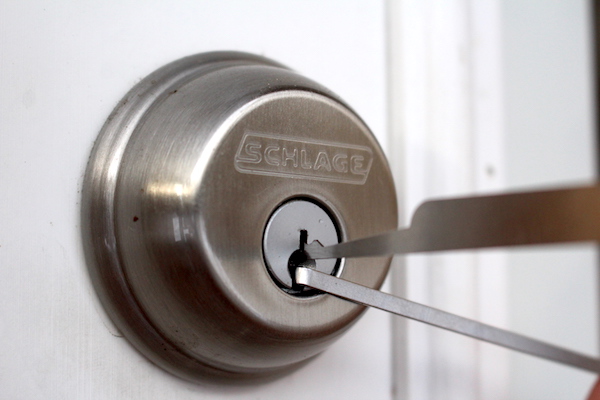
How Does a Lock Work?
To understand how to pick a lock, you first need to learn how a lock works.
A standard door lock is a pretty simple mechanism. The lock has spring-loaded pins that “set” at various depths, and once all the pins are set, the lock will open. If you look at a key, the tooth pattern will give you an idea of how the various pins are laid out.
To keep the pins set, a second tool called a tension wrench is used to apply tension to the lock. It turns the lock ever so slightly and the tension will hold the pins as each individual pin is set. Once all the pins are set, the lock will release and turn in the direction of the tension applied.
This is all you need to understand to pick a simple lock. More advanced locks have trick pins and complicated mechanisms to deceive a would-be lockpicker, but the average front door lock doesn’t employ any of these advanced pins.
You won’t find any of these advanced pins at your local hardware store, and 99.9% of homes don’t have them. It’s amazingly simple to pick a door lock, and you have to go out of your way to find a door lock that’s a challenge to get past.
This video has great visuals because it’s made by a locksmith education company, that sells training cutaway locks as a teaching tool. The video is a bit slow to get started, but at 3 minutes in he begins a demo with a cutaway lock that shows the basic principles of lockpicking:
Practical Uses for Lock Picking
Lock picking isn’t just for criminal intent, and there are plenty of day-to-day applications for this wicked fun skill. Since basic lockpicking tools are tiny, they fit easily into a wallet pocket behind a credit card.
In the event of some type of mass society collapse or pandemic, just a couple of these would come in handy quick. Long before that, having them on hand has been helpful more than once, when a friend lost their door key, and when my toddler accidentally locked themselves behind a door.
See…handy for everyday uses, that have nothing to do with ripping off your neighbor.
Beyond the day-to-day entry into places that you otherwise have a right to be, lock picking is actually a decent career path. Both my husband and the friend who introduced us to lock picking work in the computer security field, crafting defenses against computer hacking.
As electronic anti-hacking methods become more sophisticated, it’s becoming more practical to hack by breaking down physical security and just stealing the hardware.
That means that computer security professionals are now having to certify companies and businesses for physical security as well as electronic security. This line of work is called “penetration testing” and learning to pick locks and get around other security measures is just another fun skill set that’s now applicable to silicon valley companies looking to hire more “penetration testing” experts.
Studying computer science in college, my husband never imagined he’d be practicing picking locks for work, but here’s the basic toolset he keeps in his office these days…
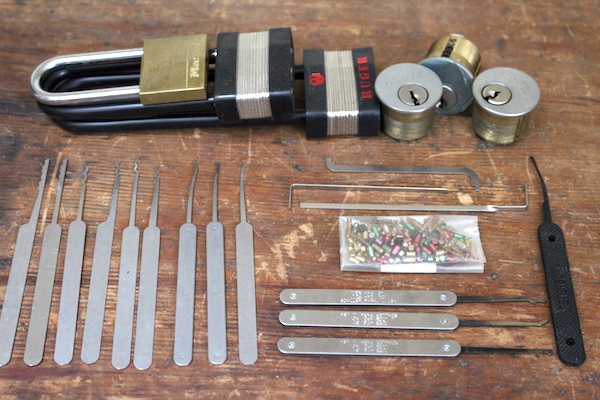
Basic Lock Picking Tools
The tools for lock picking are rather simple and really small.
You can buy sets that are large and contain dozens of picks with easy to hold handles, but really, 3-4 tiny picks that are just a few inches long, and flat are a much better choice. They’ll fit in your wallet or in a tiny compartment in your car, which is much more practical since they’ll be at hand when you need them.
This titanium lockpicking set, for example, has everything you need and the picks have a slim profile which makes them perfect for everyday carry.
The most bare-bones basic setup is just two tools, a tension wrench, and a feeler pick. You use the tension wrench to apply tension to the lock, and then the pick to set each individual lock pin while maintaining tension.
Tension Wrench
Tension wrenches come in a few different sizes and styles, based on your ergonomic preference, but also for different sizes and types of locks.
They can be simple L-shaped pieces of metal, a bit like an Allen wrench, or they can have twists or notches, all based on what you’re trying to accomplish.
The most basic type is just a small, thin L-shaped piece of metal and that’ll get the job done in most circumstances.
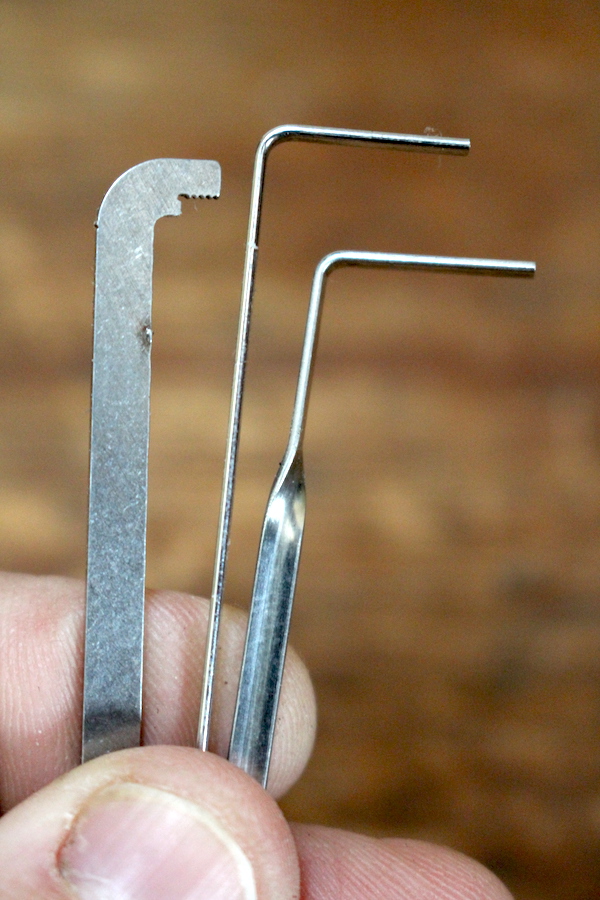
Feeler Pick
Just like the name implies, feeler picks are small picks designed to let you feel the pins inside a lock and apply pressure to them one by one.
This will let you work through a lock setting the pins methodically, and it’s my preferred way to solve the puzzle. They require a lot more practice and skill to operate than a lockpicking rake.
Once you’re skilled, feeler picks also have a higher success rate than other methods.

Lock Picking Rake
There’s another tool called a lock picking rake, and instead of attempting to set each pin individually, you can “rake” back and forth over them more or less randomly. This often works faster, but not all locks will be tripped by raking.
Personally, I’m not a fan because I think of lock picking as a puzzle.
If I’m going to spend a cold winter afternoon by the fire picking locks, I want to consciously know what I did to make that lock pop open. That’s where the puzzle aspect comes from for me, and I want to feel that last pin go and know that I solved it with that click before it opens.
Practically speaking though, raking is quick and effective in the field and if I had to get in somewhere fast, you better believe a rake pick is the first one I’d try. They come in many different styles, and each one will have a different success rate on any particular lock.
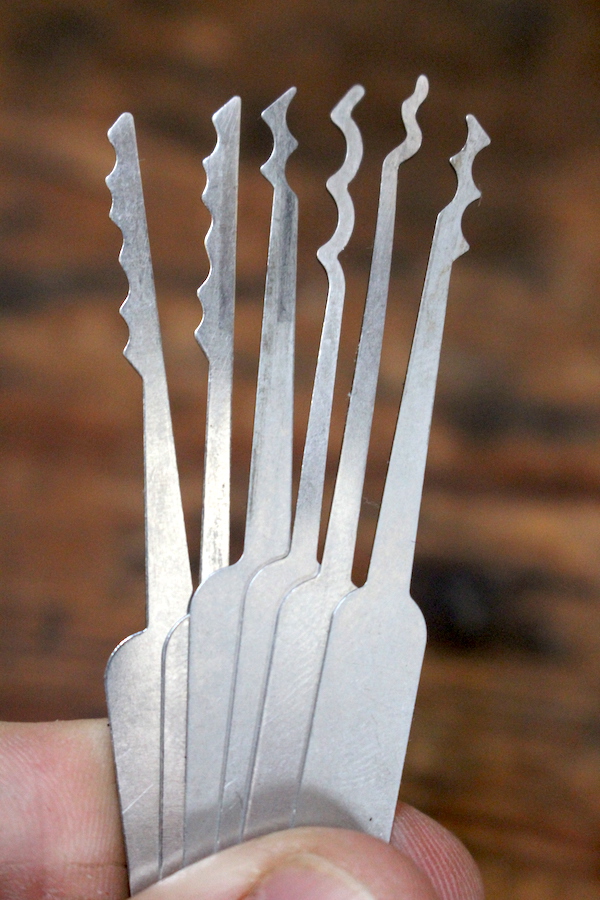
If you’re assembling a lock picking kit, choose a tension wrench, one or two types of feeler picks, and a few different rake styles.
This lock picking kit has everything you could possibly need for about 30 bucks. The slim profile handles are what I prefer (as seen in the picture above) because I can slip them into my wallet, a book, or just about anywhere to ensure I’ve got them on hand in a pinch.
I keep can keep a few picks behind my driver’s license in my wallet for emergencies.
If you want to have all the options on hand in an emergency, simple handcuff lock picks are incredibly tiny and only a few bucks. I’ll admit I’ve never tried my hand at picking handcuffs, but it’s on my lock-picking bucket list.
Advanced Lock Picking Tools
Beyond just the basics, there are always more fun toys you can acquire to help hone your skills (or just tinker with for the fun of it).
Customizable Pin Locks
If you’re going to practice lock picking, it’s a fun exercise to create your own puzzle using customizable tumblers with removable pins.
You can add in progressively harder pin types to create an ever-expanding puzzle to solve. Lacking this, just picking up every spare lock you can find, often at reclamation dumps or the like, is a great way to practice your skills on as many lock types as possible.
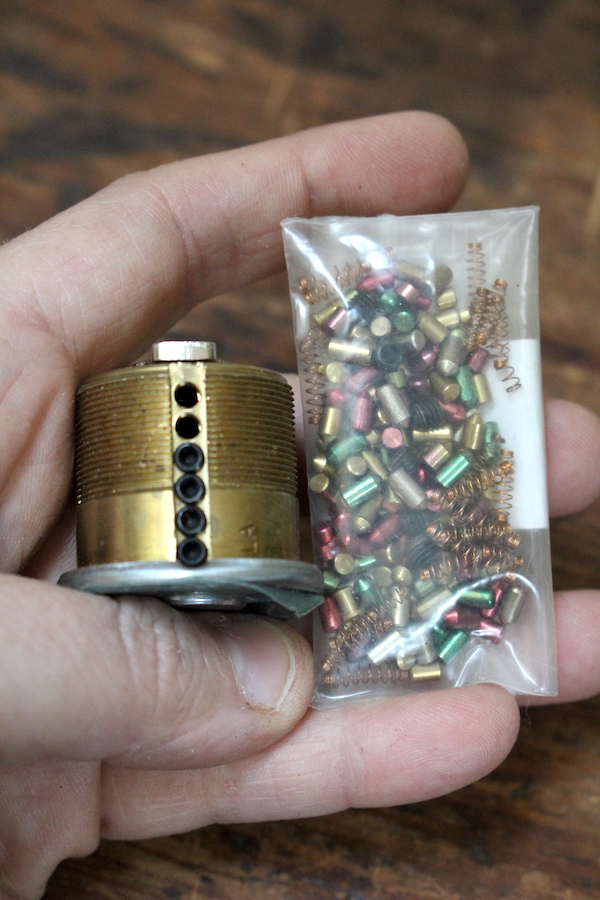
Lock Picking Practice Sets
Locksmiths actually need these skills and they have to train somehow. There are quite a few basic locksmith training kits on the market, that have cutaway visuals so you can see the pins move within the lock. Here’s a couple to try this Cutaway Lock Set for Locksmiths training.
There are a lot of options, and most of these are good beginner practice lock kits as well.
I’d also suggest reading this visual guide to lockpicking if you’re really getting into the art.
Auto Jigglers or Try Out Keys
On his next visit, the same friend who brought us our lockpicking setup brought us another present…Try Out Keys.
These are a set of “master key” like picks that auto junkyards use to start cars. Before cars had chip keys, these keys could be used to start many different models, especially fords and older model Japanese cars.
Nowadays, some types of cars don’t even have keys, just electronic sensors. So you’re out of luck with modern vehicles, but older cars are pretty easy to open with these. The first chips were introduced in 1996, and they’ve grown progressively more complex since.
These are handy to have in day-to-day situations, namely if you find someone who has locked themselves out of their vehicle. Beyond that, I know plenty of people who keep them on hand for the zombie apocalypse, where there are plenty of ownerless cars hanging out.
You can pick up a set of these for just a few bucks here or here. (They keep changing the links on these, so if they don’t work try this generic search for auto jiggler keys.)
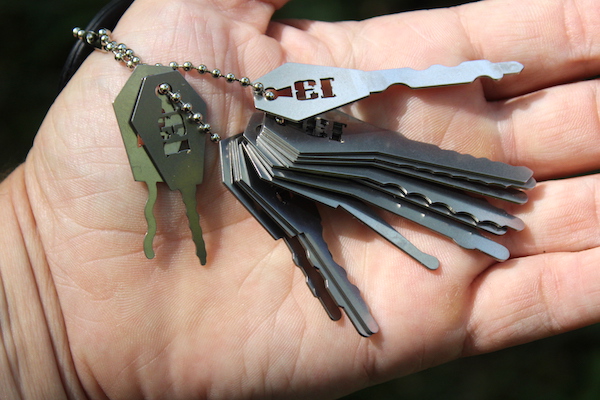
Lock Picking Gun
Why use a small, quiet pocket-sized tool when a gun will do? A lockpicking gun is basically a large tool that rakes the lock for you and can help you rapidly gain entry somewhere. It’s not artful, thoughtful, or skilled…but it is effective.
Basic lockpicking guns are pretty inexpensive too.
Improvised Lock Picks
That’s all well and good, but what happens when you find yourself locked out of your house without your trusty lock pick set? Basic lock picking tools are just tiny pieces of metal, and you can improvise them with, well, other tiny pieces of metal.
Paper clips work great in a pinch, here’s a tutorial on improvised lock picking:
Is Lock Picking Illegal?
I know what you’re thinking, just owning lock picks must be illegal. There’s no way you can just walk around with lock picks in your pocket!?!? Believe it or not, for the most part, lock picks are perfectly legal to own, provided you’re not using them for criminal purposes.
People want to believe they’re illegal, so they can believe that they’re hard to get, so they can rest more comfortably at night. The problem is it’s just not true.
Of course, if they were illegal, the only people who owned them would be criminals…legality won’t really stop them from being used to break into your house either way.
There are a few localities that restrict lock picks, but they’re by far the exception. United Locksmiths has a good primer on this, broken down by state in the US. Please do check your local area if you’re considering picking up lockpicking as a hobby.
Difficult to Pick Door Locks
My main point in this is not to teach you how to break into your neighbor’s house.
My point is, that it’s likely very easy for just about anyone to get past your current door lock. Hardware stores generally don’t carry locks that are difficult to pick because they’re catering to the mass market. If you really want something secure, you’re going to have to go out of your way to find it.
When we learned door locks were so easy to pick, my husband did a lot of research into better locks for our home. I’ll be posting some recommendations for those in an article coming soon. Sign up for email updates in the form below so you won’t miss that post.
More Lock Picking Resources
If you’re thinking lockpicking sounds like a useful skill, and you’re looking for more fun skills to pass long winter days (I’ve never been much of a knitter…) then there’s a lot to learn beyond this basic tutorial. I’d recommend picking up a good book as a starting point:
Beyond that, get a basic lockpicking set, grab a few stray locks and let the fun begin!

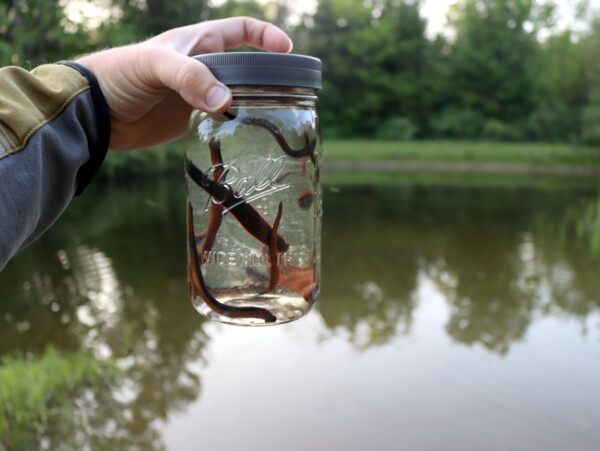

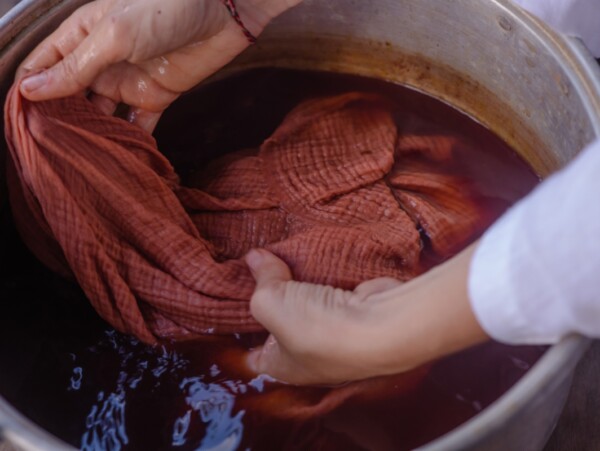

While it is possible to get into some houses with some lockpicks that have been macgyvered together I think this is a bit misleading as there are many locks out there that are very difficult to open even for experienced lockpickers with real tools. So if you are reading this don’t expect that you can get back into your house with a piece of wire if you forget your keys.
That being said lockpicking can be a very useful skill to learn.
I just love your blog. And you always come up with such wonderful and unique topics! Because it always giving us a proper guide. I think, this post is about picking a lock all about clear ideas here. Keep it up ! Thank you!
Thanks so much. We’re glad you enjoyed the post.
To properly pick a lock with a paperclip, you’ll need the right tools. Picking a lock without tools is impossible.
Hey thanks for detailed info…I’m a newbie to it all but have always had a fascination with lock picking.
I’ll certainly be staying tuned..
Cheers and thanks again
Regards
Ray
You’re very welcome. So glad you enjoyed the post.
I have sets and 2 translucent locks, I’ve been doing this since this covid19 just passing time and now I’m think of becoming a locksmith
That’s great!
Great explanation and great video.
My wife has a display cabinet but misplaced the key. She found several keys, and used a wrong key to lock the cabinet, but could not unlock it with the key.
After watching the video, it took me less than 30 seconds to unlock the cabinet using a thin allen wrench as the pick, and a paper clip as the tension wrench.
That’s so great to hear! Glad it was helpful.
Just awesome! I love the site a regular basis. Because it always giving us a proper guide. I think, this post is about picking a lock all about clear ideas here. Keep it up ! Thank you!
Just started getting into this with the pandemic going on and since I’m always locking my keys in my car. I’ve become quite fast with a $10 slim Jim from a auto part store lol. I actually just purchased 2 complete kits one with 25 rakes and different pics and the other is a 30 PC key set. You called them auto jugglers. Anyway thank you so much for your informative article it was very well written and gotten me even more enthused about perfecting the art. Also you can get these kits from the wish shopping app very cheap, I only paid 11 for both my sets and shipping now granted they’re not high quality but I think they will be absolutely perfect for a true beginner.
Awesome! I’m so glad you’re enjoying your new-found hobby!
What an absolutely delightful skill-set to have. Kudos
Hi Ashley, thank you very much for the informative introduction to lockpicking! I’m interested in purchasing a lockpicking set, but the Amazon link no longer links to an Amazon item. Would you be able to update the link, or send me a link to another recommended lockpicking set? As with other tools, knives, etc., I agree that the fewest and simplest tools are often all you need. Just need to know which lockpicking tools available for purchase fall under that category. Thanks! Katt
It’s tricky, I’ve updated the links in this article several times now and it seems like for whatever reason the sets go off the market quickly.
If you’re looking for something that’s more everyday carry, where you’d slip a few into your wallet for emergencies, this kit here has the small handle-less picks that I’ve gotten used to: https://amzn.to/3JwUx0u
It contains everything you’ll need and then some, and the smaller form factor means you can pick the few that you’re best at using once you’ve practiced a bit and then keep those on you.
Thanks for the heads up, I’ll go back in and update that link in the article.
I just love your blog. And you always come up with such wonderful and unique topics!
As a newbie to Central Vermont and just getting started in our own more modest homesteading goals it’s fantastic inspiration. Thank you!!
Awesome Amy! Welcome to Vermont =)